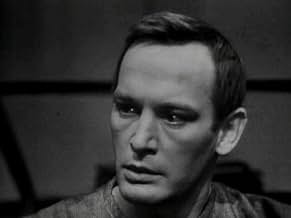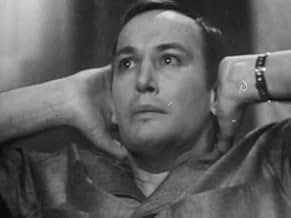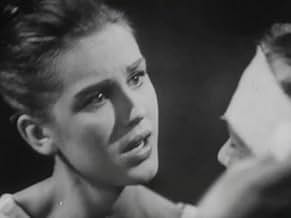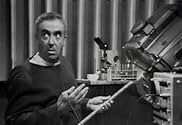Kris Kelvin joins the space station orbiting the planet Solaris, only to find its two crew members plagued by "phantoms," creations of Solaris. Kelvin is soon confronted with his own phantom... Read allKris Kelvin joins the space station orbiting the planet Solaris, only to find its two crew members plagued by "phantoms," creations of Solaris. Kelvin is soon confronted with his own phantom, taking the shape of his dead wife Hari.Kris Kelvin joins the space station orbiting the planet Solaris, only to find its two crew members plagued by "phantoms," creations of Solaris. Kelvin is soon confronted with his own phantom, taking the shape of his dead wife Hari.
Vasiliy Lanovoy
- Kris Kelvin
- (as V. Lanovoy)
Antonina Pilyus
- Hari
- (as A. Pilyus)
Vladimir Etush
- Snaut
- (as V. Etush)
Viktor Zozulin
- Sartorius
- (as V. Zozulin)
Featured reviews
Cosmonauts on a space-station orbiting a world dominated by a seemingly sentient ocean are visited by 'people' from their past who appear to have been created by the ocean based on difficult or repressed memories. This Russian TV-movie preceded the much better known 1971 Andrei Tarkovsky film version and, although somewhat closer to Stanislaw Lem's eponymous novel, is equally cryptic (and slow-moving). The focus of Lem's original story is on the impossibility of communicating with, or even acquiring a basic understanding of, a completely alien life form (one reason the author chose to make the alien a sentient ocean was to make it harder to anthropomorphise). Basing an entire movie on failing to understand the inexplicable is challenging, so all three film versions (1968, 1971 and 2002) focus more on the relationship between cosmonaut Kris Kelvin (Vasily Lanovoy) and the simulacrum 'visiting' him: Harey (Antonina Pilyus), his wife that committed suicide for which he feels much guilt. Lem was not impressed by the film versions of his story (his comment on the 2002 version was '...the book was entitled "Solaris" and not "Love in Outer Space"). The 1968 B/W version, which was a low-budget production with limited sets and no special effects, is visually less interesting than 71's colour version, and the story is very slow-moving, but the cast seems good (I was watching an English subtitled version on YouTube) and, even with the shift to a relationship drama, Lem's story remains compelling. All in all: more interesting than entertaining but fans of the genre should find it worth hunting down.
Full review on my blog max4movies: Solyaris is the first adaptation of Stanislaw Lem's novel of the same name. It's a two-part made for television movie about a scientist who encounters his dead wife on a space station orbiting a sentient planet. The movie heavily focuses on philosophic discussions about morality and stays more closely to the original novel than the other cinematic adaptations by Tarkowski and Soderbergh. Technically, the movie is dated and the generally low production values and the minimalistic setting will turn off some viewers. In addition, the slow pacing of the frequent dialogue scenes and the sometimes middling performances don't necessarily make the movie entertaining. However, the plot is intriguing and faithful to the source material, some dialogues are clever, and the black and white cinematography also make this science fiction drama atmospheric.
Well, watching TV movies from the Soviet Union is a new experience to me, but being a big fan of Tarkovsky's Solaris (1972), I was always naturally curious to see the true original. I've now seen and reviewed all three film versions of Solaris (the other being the Americanized 2002 version).
Seeing this leads to a better understanding of why Tarkovsky's feature film was necessary- this 1968 film is not satisfactory, and bears parallels to TV movies produced in Western society in later decades. You can see what's missing from this version, and what Tarkovsky added- a Kris Kelvin with sad eyes, a more distressed and lost Hari, a moody score (the 1972 film makes brilliant use of Bach's Ich ruf' zu dir, Herr Jesu Christ), and a convincing sense of Kelvin's deterioration. It's missing the convincing, colourful sets (according to Akira Kurosawa, Tarkovsky's budget was quite extravagant). It's missing some subtlety, as Kelvin's narration tells us Hari can't be Hari the first time she appears, and Snaut and Sartorius explain to each other why Kelvin won't let go of Hari. It's missing the foreshadowing that came with Burton's video in the 1972 film.
Of course, Solaris is a great story, and much of the story is conveyed here. It is merely presented in a blander, less hypnotic and ultimately forgettable style.
Seeing this leads to a better understanding of why Tarkovsky's feature film was necessary- this 1968 film is not satisfactory, and bears parallels to TV movies produced in Western society in later decades. You can see what's missing from this version, and what Tarkovsky added- a Kris Kelvin with sad eyes, a more distressed and lost Hari, a moody score (the 1972 film makes brilliant use of Bach's Ich ruf' zu dir, Herr Jesu Christ), and a convincing sense of Kelvin's deterioration. It's missing the convincing, colourful sets (according to Akira Kurosawa, Tarkovsky's budget was quite extravagant). It's missing some subtlety, as Kelvin's narration tells us Hari can't be Hari the first time she appears, and Snaut and Sartorius explain to each other why Kelvin won't let go of Hari. It's missing the foreshadowing that came with Burton's video in the 1972 film.
Of course, Solaris is a great story, and much of the story is conveyed here. It is merely presented in a blander, less hypnotic and ultimately forgettable style.
Did you know
- ConnectionsRemade as Solaris (1972)
Details
- Runtime2 hours 22 minutes
- Color
Contribute to this page
Suggest an edit or add missing content
























